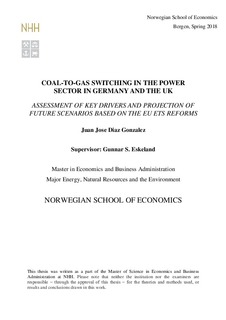Coal-to-gas switching in the power sector in Germany and the UK : assessment of key drivers and projection of future scenarios based on the EU ETS reforms
Master thesis
Permanent lenke
http://hdl.handle.net/11250/2560509Utgivelsesdato
2018Metadata
Vis full innførselSamlinger
- Master Thesis [4379]
Sammendrag
The power sector represents 30% of total greenhouse gas (GHG) emissions in the European
Union (EU). Market concentration and use of available technologies combined with a carbon
price could trigger drastic GHG emission reductions. In light of this, the EU introduced in
2005 the Emissions Trading Scheme (ETS), a market driven mechanism that sets a price on
carbon. Nevertheless, the EU ETS has performed below expectations in generating an
effective price signal. Coal represents the main emitting fuel source with about 39% of all
EU-ETS emissions resulting from coal power generation. It is undeniable that today fuel
combustion plants are needed to maintain a stable power system due to the intermittency of
renewable power sources. However, fuel switching from coal to natural gas (referred as “gas”
from now on), a less carbon-intensive fuel source, represents a feasible solution to drastically
reduce emissions. In this context, the EU roadmap towards 2050 aims for progressive
emission reductions as renewable energy gains relevance in the energy mix. This can only be
achieved through a progressive transition from coal to gas technologies. Over the last years,
the diverging coal and gas economics, have made necessary the role of a carbon price to
increase gas competitiveness and allow for a so-called coal-to-gas switch. The German and
United Kingdom (UK) power sectors combined represent approximately 30% of the total
GHG emissions in the EU. Moreover, their coal-to-gas switching strategies differ
considerably. While Germany is a loyal advocate of free-markets, the UK has numerous
occasions favoured market intervention. The UK has introduced a carbon price floor and
announced a coal-phase out by 2025, while Germany has taken a more passive position
letting the EU ETS define the optimum carbon price signal conditions through socioeconomic
arguments. Recently approved adjustments to the EU ETS may increase the carbon
price significantly in the next decade, which could support Germany´s strategy thereby
avoiding the social and economic burden of market intervention. On the other hand, if the
carbon price signal is not strong enough, Germany would be obliged to introduce stringent
policy measures to limit coal power generation. The question over which is a better strategy
to support an effective coal-to-gas switch is a topic of debate among the EU member states.
This thesis evaluates the key drivers behind the coal-to-gas switching process, compares the
situation of Germany and the UK, and analyses different carbon price scenarios up to 2030 in
order to project possible coal-to-gas switching outcomes. This will aid in judging which
strategy is the most appropriate to accomplish an efficient coal-to-gas switching process,
which is crucial for the realization of the 2030 emission reduction targets.
